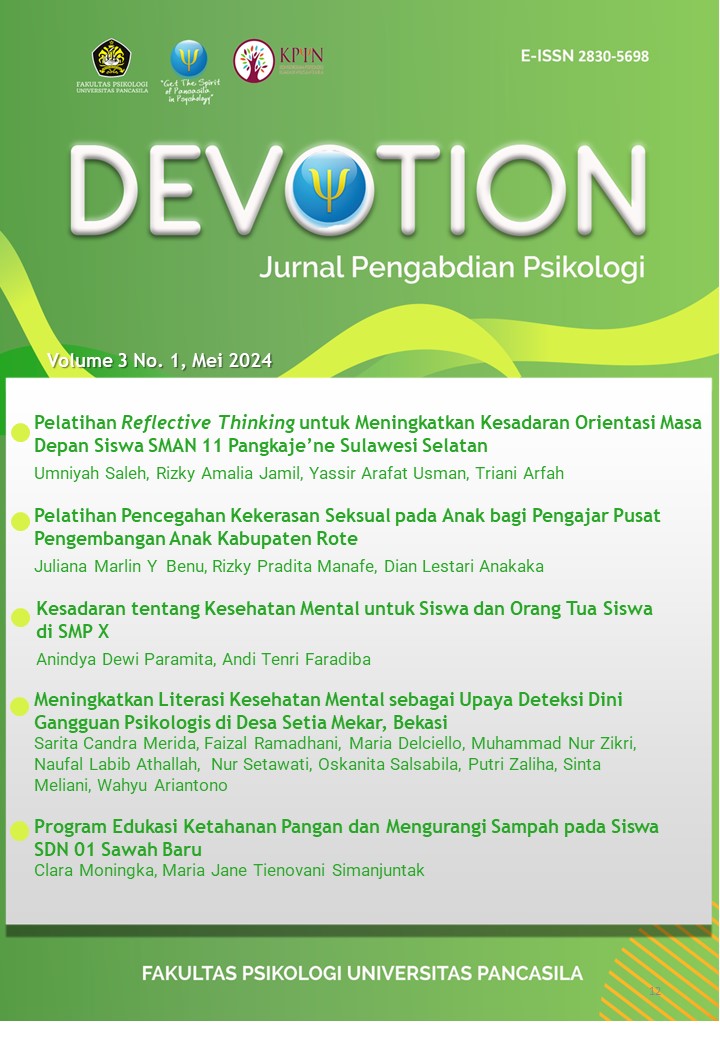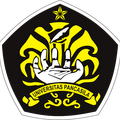Pelatihan Reflective Thinking untuk Meningkatkan Kesadaran Orientasi Masa Depan Siswa SMAN 11 Pangkaje’ne Sulawesi Selatan
DOI:
https://doi.org/10.35814/devotion.v3i01.5864Keywords:
adolescent, future orientation, reflective thinkingAbstract
Adolescents are the next generation of the nation who will contribute greatly to the development of Indonesia’s human resources. The adolescent phase is an important stage to start forming a clear self-identity including in terms of future planning. However, adolescents often experience confusion regarding their future orientation, making it difficult to set goals and strategies to achieve the future. Although most of them have aspirations, it is less based on the ability to recognize themselves related to their strengths and weaknesses. According to the literature review, the reflective thinking method applied through reflection of experience is an important learning model. With this method, individuals can better recognize their potential based on the meaning of their past experiences. This training was conducted for two days on 24 - 25 May 2023 at SMA Negeri 11 Pangkaje'ne, with a total of 31 participants who were students of class XI. The results of this training show that the ability to think reflectively in interpreting experiences will help adolescents recognize their strengths and weaknesses, as well as their interests and talents. This can be a reference for them in setting future goals. A clear future direction can lead adolescents to set specific steps and strategies to achieve their goals. This will increase the chances for adolescents to get a decent job and have a career that suits their potential in the future.
References
Amulya, J. (2004). What is reflective practice. Center for Reflective Community Practice, Massachusetts Institute of Technology, Cambridge. http://www.itslifejimbutnotasweknowit.org.uk/files/whatisreflectivepractice.pdf
Borowsky, I. W., Ireland, M., & Resnick, M. D. (2009). Health status and behavioral outcomes for youth who anticipate a high likelihood of early death. Pediatrics, 124(1), e81-e88.
Creed, P., Patton, W., & Prideaux, L. A. (2006). Causal relationship between career indecision and career decision-making self-efficacy: A longitudinal cross-lagged analysis. Journal of Career Development, 33(1), 47-65.
Dewey, J. (1933). How we think: A restatement of the relation of reflective thinking to the educative process. D. C. Heath.
Ferrer-Wreder, L., Lorente, C. C., Kurtines, W., Briones, E., Bussell, J., Berman, S., & Arrufat, O. (2002). Promoting identity development in marginalized youth. Journal of Adolescent Research, 17(2), 168-187.
Grinder, R.E. (1978). Adoleseceant (2nd ed.). John Wiley and Sons Inc.
Johnson, S. R. L., Blum, R. W., & Cheng, T. L. (2014). Future orientation: A construct with implications for adolescent health and wellbeing. International Journal of Adolescent Medicine and Health, 26(4), 459-468.
Kappes, H. B., & Oettingen, G. (2012). Wishful information preference: Positive fantasies mimic the effects of intentions. Personality and Social Psychology Bulletin, 38, 870–881.
Kerpelman, J. L., & Mosher, L. S. (2004). Rural african american adolescents' future orientation: The importance of self-efficacy, control and responsibility, and identity development. Identity, 4(2), 187-208.
Kolb, A. Y., & Kolb, D. A. (2005). Learning styles and learning spaces: Enhancing experiential learning in higher education. Academy of Management Learning & Education, 4(2), 193-212.
Lyons, N. (2010). Handbook of reflection and reflective inquiry: Mapping a way of knowing for professional reflective inquiry. New York: Springer.
Moss, S. A., Wilson, S. G., Irons, M., & Naivalu, C. (2017). The relationship between an orientation to the future and an orientation to the past: The role of future clarity. Stress and Health, 33(5), 608-616.
Nurmi, J. E. (1987). Age, sex, social class, and quality of family interaction as determinants of adolescents' future orientation: A developmental task interpretation. Adolescence, 22(88), 977.
Nurmi, J. E., & Pulliainen, H. (1991). The changing parent-child relationship, self-esteem, and intelligence as determinants of orientation to the future during early adolescence. Journal of Adolescence, 14(1), 35-51.
Ostaszewski, K., & Zimmerman, M. A. (2006). The effects of cumulative risks and promotive factors on urban adolescent alcohol and other drug use: A longitudinal study of resiliency. American Journal of Community Psychology, 38, 237-249.
Pruzzan, K., & Isaacowitz, D. M. (2006). An attentional application of socioemotional selectivity theory in college students. Social Development, 15, 326–338.
Shermis, S. S. (1999). Reflective Thought, Critical Thinking. ERIC Digest.
Steinberg, L. (2008). A social neuroscience perspective on adolescent risk-taking. Developmental Review, 28(1), 78-106.
Suyanto & Jihad, A. (2013). Menjadi Guru Profesional. Erlangga.









